Gastro Oesophageal Reflux Disease
The oesophagus carries food from the mouth to the stomach. The lower oesophageal sphincter is a ring of muscles that acts like a valve between the oesophagus and stomach.
Gastro oesophageal reflux disease (GORD) is a chronic disease that occurs when the lower oesophageal sphincter does not close properly and stomach contents leak back or reflux into the oesophagus.
When refluxed stomach acid touches the lining of the oesophagus, it causes a burning sensation in the chest or throat called heartburn. The fluid may even be tasted in the back of the mouth, and this is called acid indigestion. Occasional heartburn is common but does not necessarily mean one has GORD. Heartburn that occurs more than twice a week may be considered GORD, and it can eventually lead to more serious health problems.
Anyone, including infants, children, and pregnant women, can have GORD.
Symptoms
The main symptoms are persistent heartburn and acid regurgitation. Some people have GORD without heartburn. Instead, they experience pain in the chest, hoarseness in the morning, or trouble swallowing. You may feel like you have food stuck in your throat or like you are choking or your throat is tight. GORD can also cause a dry cough and bad breath.
Most symptoms of GORD are so common that they may not be associated with a disease. Consultation with a physician is essential for proper diagnosis and treatment of GORD.
Causes
- Hiatal hernia, which occurs when the upper part of the stomach bulges through the opening in the diaphragm (muscle wall that separates the stomach from the chest).
- alcohol use
- overweight
- pregnancy
- smoking
Certain food and drinks are also associated with reflux.
Diagnoses
- Medical history
- Response to Omeprazole
A recent study 12, demonstrated a potential role for a proton pump inhibitor, omeprazole, in the diagnosis of GORD. - Barium swallow radiograph uses X-rays to help identify abnormalities such as a hiatal hernia and severe inflammation of the oesophagus.
- Endoscopy
Treatment
Conservative treatment
- Lifestyle modification
- Medications including antacids, foaming agents, H2 receptor blockers, proton pump inhibitors
Surgical treatment
SSurgery is an option when medicine and lifestyle changes do not help relieve symptoms.
Laparoscopic Nissen Fundoplication
This surgery is performed under general anaesthesia.
If a combination of lifestyle changes and drug therapy does not remedy reflux symptoms, a Nissen fundoplication can be a very effective surgical procedure to correct reflux. This procedure involves wrapping the upper portion of the stomach around the base of the oesophagus to reinforce the strength of the lower oesophageal sphincter. Until recently, the procedure required a large abdominal incision. A hospital stay of 3-5 days was usually required, and the time to full recovery and return to work was measured in weeks.
A laparoscopic Nissen fundoplication is a minimally invasive approach that involves the use of specialised video equipment and instruments that allow your surgeon to perform the procedure through four tiny incisions, most of which are less than a half-centimetre in size.
One advantage of this method is a brief hospitalisation. Most often it will require an overnight stay. Other advantages include less pain (reduced need for pain medication), fewer and smaller scars and a shorter recovery time.
Laparoscopic Nissen fundoplication is a safe and effective treatment of GORD. However, in rare cases the laparoscopic approach is not possible because it becomes difficult to visualise or handle organs effectively. In such instances, the traditional incision may need to be made to safely complete the operation.
Suite 2 Strathfield Private Hospital
3 Everton Rd
Strathfield 2135
East Sydney Private Hospital
75 Crown Street
Woolloomooloo
NSW, 2011
Royal Prince Alfred Hospital
50 Missenden Rd
Camperdown
NSW 2050
Concord Hospital
Hospital Rd
Concord
NSW 2139














